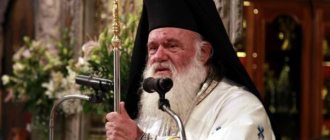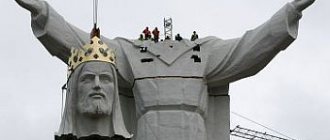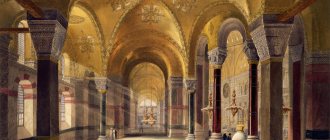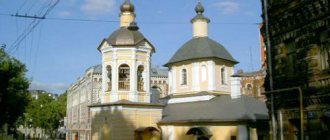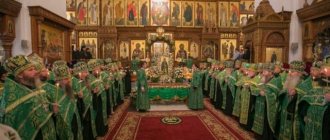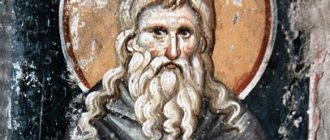History[edit | edit code]
It was created in 1944, when the Voroshilovgrad Vicar See was founded in Voroshilovgrad (now Lugansk), to which Bishop Nikon (Petin) was installed. In 1948, the bishop was transferred to Odessa. After this, the Voroshilovgrad-Donetsk diocese was under the jurisdiction of the Odessa bishops. After Archbishop Nikon, its managers were in 1956-1965 Metropolitan Boris Vik and in 1965-1990 Metropolitan Sergius (Petrov).
In February 1990, Bishop Ioannikiy (Kobzev) was installed at the see. In October 1991, due to the growing number of parishes in the Donbass, the diocese was divided into two separate church regions. The resulting Lugansk and Starobelsk diocese remained under the spiritual tutelage of Metropolitan Ioannikios.
In May 2007, by decision of the Holy Synod of the UOC (MP), the diocese was divided into two independent ones: Lugansk-Alchevsk and Severodonetsk-Starobel.
LUGANSK AND ALCHEVSK DIOCESE
14 Feb 1943 Lugansk was liberated from the occupiers, September 8 - Yuzovka. No later than con. 1943 within the Stalin region. The Stalin diocese was formed. 31 Dec 1943 The Synod of the Russian Orthodox Church decided to commission Bishop. Rostov and Taganrog Eleutherius (Vorontsov) “to resolve cases in the Stalin region.” By that time, the St. Nicholas Church in Stalin, the St. Nicholas Church in Voroshilovgrad, the St. Nicholas Cathedral in Voroshilovsk and the Trinity Church in Slavyansk had the status of cathedral churches in Donbass. In 1943-1944. Church life in the Luhansk region was led by the rector of the Voroshilovgrad Cathedral and the dean of the Voroshilovgrad region: priest. Joakim Oleksyuk (until September 1944), archpriest. Evfimy Kachan (since September 1944).
Peter and Paul Cathedral in Lugansk. 1793-1795 Photo. 2010 Peter and Paul Cathedral in Lugansk. 1793-1795 Photo. 2010
Soon after the liberation of Donbass, arrests took place among the region's few clergy. In 1943-1945. priests were arrested. Joseph Sukhoshin-Sukhomlinov, who opened the Peter and Paul Church in Lugansk, priest. Feodor Romashkevich from the village. Bokovo-Anthracite (now the city of Anthracite), John Kreshchanovsky from Bakhmut, John Kolesnikov and Sergius Durnitsky, but already in the beginning. 50s all five were amnestied, which indicates the falsity of the charges of collaboration (TSGAVOGVU. F. 4648. Op. 3. D. 128. L. 207). The temple in Bokovo-Antratsit was closed by local authorities, which led to mass protests by residents of this village and the neighboring village. Sharapkino in con. 1943 - beginning 1944 At the end. 40s XX century were repressed by the former. subdeacons ep. Dnepropetrovsk-Donetsk Demetrius (Magan) - psalmist Kirill Litvinenko, associated with the catacomb movement, and priest. Panteleimon Kozinsky.
In a document of the Moscow Patriarchate dated April 14. 1944, the dioceses of the south-east of Ukraine revived during the occupation period were named, the existence of which was recognized by the hierarchy of the Russian Orthodox Church: Dnepropetrovsk, Zaporozhye, Voroshilovgrad-Stalin (it was temporarily ruled by the Dnepropetrovsk-Zaporozhye Archbishop Andrey (Komarov)) (GARF. F. 6991 Op. 2. D. 4. L. 5). On May 19, 1944, the Synod issued a decree appointing priest Bishop of Voroshilovgrad. Alexandra Petin upon his tonsure as a monk. (Previously, a meeting of the local clergy elected the dean of the Voroshilovgrad district, priest Joachim Oleksyuk, to the Voroshilovgrad department. In March 1944, Metropolitan Sergius (Stragorodsky) discussed this candidacy with the head of the Council for the Affairs of the Russian Orthodox Church G. G. Karpov, but the latter rejected this appointment due to "anti-Soviet" sermons of Oleksyuk during the occupation. On this charge, priest Joachim was arrested on September 16, 1944 and deported to Kazakhstan.) On May 21, 1944, priest. Nikon (Petin) was consecrated Bishop of Voroshilovgrad, vicar of the Dnepropetrovsk diocese. In Jan. 1945, he is already referred to as an independent bishop of Voroshilovgrad and Stalin, in a document dated February 21. 1945 First named Bishop of Donetsk and Voroshilovgrad. On March 10, 1945, the Synod decided to appoint bishop. Nikon to the Lviv-Ternopil Department, April 18. this decision was canceled due to his ignorance of Ukrainian. language.
Having settled in Voroshilovgrad, Bishop. Nikon began organizing diocesan administration. In 1945-1947 In Voroshilovgrad, there was a diocesan chancellery, which was headed by priests Nikolai Klebanovsky (1945-1947) and Nikolai Gavrilov (from 1947). The position of EU Commissioner for the Stalin Region was introduced. In 1944-1945 This position was held by Fr. Gabriel Kokhanov, rector of the St. Nicholas Church in the Stalino-Zavodsky district of the city of Stalino, in 1945-1946 - prot. Pyotr Sergeev, rector of the St. Nicholas Church at the Stalino railway station. In 1946, bishop. Nikon formed the secretariat of the Voroshilovgrad diocese in the Stalin region; the head of the secretariat, which became the priest. Gabriel Kokhanov received the position of authorized representative of the bishop in the Stalin region. However, due to protests from the commissioner of the Council for the Affairs of the Russian Orthodox Church, the bishop abolished the secretariat in 1947 and from that time worked directly with the deans. In 1947, the Voroshilovgrad-Donetsk diocesan council was formed. On May 6, 1947, by decree of Bishop. Nikon organized a diocesan missionary council. In 1947 in Voroshilovgrad, on the initiative of Bishop. Nikon, 3-month theological and pastoral courses were conducted for the clergy, which were taught by Archim. Nathanael (Smerdynsky) and prof. theology I. G. Aivazov.
By 1 Oct. In 1944, there were 361 parishes in the diocese. In Voroshilovgrad region. there were 128 parishes, 150 priests served in the Stalin region. there were 233 communities and 196 priests. In 1946 in the Voroshilovgrad region. There were 129 parishes (in 1945 a church was opened in the village of Illyria, Uspensky district), and in the Stalin region there were 215 parishes. The struggle of parishioners for the opportunity to register Orthodoxy. community in the village Bokovo-Anthracite was a success, and by a resolution of the Council for the Affairs of the Russian Orthodox Church dated July 18, 1947, this parish received registration. At the same time, a new temple was opened in the village. Shchetinin, Bokovo-Antratsitovsky district. Ep. Nikon sought permission from the authorities to restore it in the Voroshilovgrad region. closed in the 20s. XX century Mont-Rei: Starobelsky in honor of the icon of the Mother of God “Joy of All Who Sorrow” and Razdabarovsky, pointing to the fact that a group of nuns of the former. Starobelsky Sorrowful Monastery wants to legalize. The authorities refused and soon moved on to repress those who were considered organizers of secret monasteries or illegal parish communities. The priests were arrested. Sergiy Petrov from Pervomaisk (1945), mon. Antonia (Smirnova) from Kremennaya (1946).
In 1945 in the Voroshilovgrad region. a number of clergy were awarded state awards. awards for cooperation with the partisan movement, for active participation in fundraising for the benefit of the Soviet Army and for the restoration of Donbass (started in 1945 by decision of Bishop Nikon): Prot. John Rashkevich (Popasnaya), priest. Leonty Yarzhemsky (Kamennobrodsky parish in Lugansk, during the occupation he was the confessor of the Lugansk deanery district), Yakov Voichenko (Verkhny town, Lisichansky district), Mikhail Tereshchenko (Almaznoye village, Kadievsky district), Vasily Popov (Verkhne-Verkhne-Verkhne district) Teplya Verkhneteplovsky district).
Local authorities resolutely suppressed attempts to hold unauthorized religious services, despite the fact that the number of operating churches did not meet the needs of the believing population. So, in 1946, priest. Ioann Kutepov from the village. Maloivanovka opened a house church in the village. Yuryevka, Aleksandrovsky district, for which he was subjected to strict punishment, the temple was dismantled. The priest was punished. Mikhail Mogushy, rector of the parish in the village. Pervomaika of the Krasnodon region, which consecrated the well and installed a chapel over it. In 1950, the priest was tried for a similar violation. Nikanor Gorodovnikov from the village. Svyatohorivka, Dobropolsky district, thanks to Krom, the miraculous spring near Svyatohorivka became revered in the diocese. In 1946, for unauthorized service of liturgies in a private house in the regional center of Troitskoye, the priest was deregistered. Nikolay Krakhmalev. In Jan. 1946 Commissioner for the Affairs of the Russian Orthodox Church in the Voroshilovgrad Region. P. Karikov forbade the religious procession to the river on Epiphany. Lugan and insisted on holding a water prayer service in the church fence (TSGAVOGVU. F. 4648. Op. 3. D. 23. L. 171). The famine of 1946-1947 had serious consequences for church life; under these conditions, many The clergy left the Donbass, primarily the northern, agricultural part of the Lugansk region, which suffered the most during this period.
In con. 40s - early 50s XX century arrests and expulsions of clergy disloyal to the authorities were carried out in connection with their accusations of holding illegal religious processions, performing services outside churches, etc. Thus, in 1947, priest was arrested. Simeon Kalinin from Popasnaya, Voroshilovgrad region, in 1950 - priest. Mikhail Raevsky from Debaltsevo, Stalin region. It was widely practiced to confiscate capacious churches from the Church in exchange for unsuitable buildings. This happened in 1948 with the Voznesenskaya Church. in the village M. Vergunka, from St. George's Church. in B. Vergunka, with a temple in Rovenki. By order of the Council for the Affairs of the Russian Orthodox Church dated October 15. In 1949, the diocese vacated the building of the St. Nicholas Cathedral in Voroshilovgrad, the clergy of the cathedral were transferred to the Peter and Paul Church in the Kamennobrodsky district of Voroshilovgrad. The authorities allocated a private house to the Nikolskaya community on the outskirts of the city, in the village. Gusinovka, which was allowed to be rebuilt as a temple. The consecration of the newly built St. Nicholas Cathedral took place in 1951. At the same time, the Peter and Paul Church remained the cathedral.
In 1949, churches were closed in the villages of Osinovo, Novopskovsky district, Kuzemovka and Raigorodka, Svatovsky district, Kuryachevka, Starobelsky district, Litvinovka, Evsugsky district, in the villages of Uspenka, Serebryanka, Lisichansky district, in the village. Grechishkino, Novoaidarsky district. After complaints to Moscow from community members and the bishop, the parish in the village. Grechishkin was reinstated in January. 1950 In the same year the temple in the village was closed. Zaidarovka (now Novopskovsky district), in 1951 - a temple in the village. Zakotny, Novopskovsky district. By 1952 in the Voroshilovgrad region. there were 122 registered communities in the Stalin region. 195 communities were registered. In 1952, for the first time since the godless Five-Year Plan, the authorities in the Donbass returned to the practice of confiscating churches for granaries. Thus, the Stalin Regional Executive Committee decided to “temporarily pour grain into a church building” in the village. Novoivanovka, Amvrosievsky district. In response to the complaint of Bishop. Nikon The Council for the Affairs of the Russian Orthodox Church confirmed the legality of these actions by its resolution dated October 2. 1952 Local authorities promised to return the temple after a new granary was built in the village, but they did not keep their promise, and in 1956 the parish in Novoivanovka was deregistered, the temple building was officially seized in favor of the state.
In 1947, Bishop Nikon had a conflict with the Commissioner for the Affairs of the Russian Orthodox Church in the Stalin Region. due to the confiscation of the Trinity Cathedral in Slavyansk, which negatively affected the further relations of the bishop with the authorities. Aug 3 1948 Patriarch of Moscow and All Rus' Alexy I issued a decree on the assignment of bishop. Donetsk and Voroshilovgrad Nikon of temporary management of the Odessa diocese. By the decision of the Synod of October 21. 1949 Nikon was appointed Bishop of Kherson and Odessa, leaving him in charge of the Voroshilovgrad-Stalin diocese, which implied the bishop’s move from Voroshilovgrad to Odessa.
16 Apr 1956 in Odessa, Archbishop. Nikon died. By Synodal decision of April 25. In 1956, Archbishop was appointed temporary administrator of the Voroshilovgrad-Stalin diocese. Boris (Vic) of Odessa and Kherson, who was also exarch in the North. and Yuzh. America. He arrived in Voroshilovgrad on November 28. 1956 Archbishop. Boris made an attempt to organize the church-administrative apparatus in the Voroshilovgrad and Stalin regions. By decree of December 6. In 1956, he resumed the activities of the diocesan council in Voroshilovgrad (which had ceased due to the death of Archbishop Nikon), the head of which and the secretary of the Donetsk-Voroshilovgrad EU became Archpriest. Nikolai Panchenko from Voroshilovgrad, EU secretary for the Stalin region. and the dean of the Stalin district. Prot. was appointed. Roman Duravkin, rector of the church in the village. Kalinovka of the Stalin City Council. At the request of the authorities, Archbishop. Boris expelled the former from the diocesan council. Diocesan Secretary Archpriest Grigory Gavrilenko and former Dean of Voroshilovgrad district. prot. Euphemia Kachana. Archbishop Boris transferred to the Stalin region. Archimandrite of the parish in Starobelsk. Ambrose (Toropchenko), around whom a group of nuns of the former Starobelsk Skorbyashchensky wives was organized. mon-rya. Despite such concessions, already in 1958 a separate EU secretariat for the Donetsk region. had to be abolished at the request of the authorities. Instead, there was a diocesan council under the Donetsk department, which in 1959 was headed by the dean of the Lugansk city district. prot. Vasily Pozharsky. Half of the council members were from the Lugansk region, half from the Donetsk region. In fact, the center of the diocese continued to be in Lugansk. With the blessing of Archbishop. Boris's diocesan council on May 19, 1958 issued a circular for deans on strengthening anti-sectarian work in connection with the spread of sects in the region (TSGAVOGVU. F. 4648. Op. 3. D. 212. L. 165).
From 28 Dec. 1956 to 8 Sep. 1958, during the archbishop's vacation. Boris due to illness, the temporary manager of the Voroshilovgrad-Donetsk diocese was bishop. Baltic and vicar of the Odessa diocese Donat (Shchegolev). In the beginning. 1958 Met. Krutitsky Nikolai (Yarushevich) made a proposal to divide the Donetsk-Voroshilovgrad (since March 1958 Donetsk-Lugansk) diocese into 2 regions. diocese under control Ep. Donata. Archbishop Boris in Dec. 1958, in the context of the deployment of a new anti-church campaign (see article N.S. Khrushchev), turned to the commissioner for the Stalin region. K. Chernomorchenko with a request that “through the Council for the Affairs of the Russian Orthodox Church, he expressed his opinion that there is no need for an independent bishop in the Donetsk and Lugansk dioceses, so that in Moscow they convincingly advise the Patriarch and Metropolitan. Krutitsky" (TSGAVOGVU. F. 4648. Op. 3. D. 212. L. 162).
In the beginning. In 1958, in the Donetsk-Voroshilovgrad diocese there were 308 parishes, of which 188 were in the Stalin region. and 120 - in the Lugansk region. In 1958, in the Lugansk region, churches were closed in the villages of Pervomaika in the Svatovsky district, Davydovo-Nikolskoye in the Novosvetlovsky district, Petrovka in the Verkhneteplovsky district, and Baranikovka in the Belovodsky district. Mass protests by parishioners and clashes with the police accompanied the closure of churches in 1960 in the village. Krasny Yar Lugansk City Council and in the village. Almaznaya Kadievsky City Council. In the beginning. 1962 Commissioner for the Affairs of the Russian Orthodox Church in the Lugansk region. stated Metropolitan. Boris (Vik) about the need to vacate the building of the Peter and Paul Cathedral in Lugansk, which was used as a cinema until 1941. Instead of the cathedral, the diocese transferred the building of the Donetsk-Lugansk EU to the Lugansk City Communal Service; EU employees went to work in a house on the outskirts of the city, which previously belonged to Metropolitan. Boris. (Later, the head of the Council for the Affairs of the Russian Orthodox Church under the Council of Ministers of the Ukrainian SSR, G. P. Pinchuk, accused the Lugansk Commissioner P. Goloshchapov of “an unscrupulous deal with the clergy.”) The second cathedral church of the diocese is St. Nicholas Cathedral in the village. Shakhtostroitel (within Donetsk) - was closed in 1963, the new place of ministry of the bishop was St. Nicholas Cathedral in the village. Larinka (within Donetsk). The community of the closed cathedral was given a small private house in the same area of Donetsk as compensation. In Lugansk, by a resolution of the Council for the Affairs of the Russian Orthodox Church dated September 14. In 1961, the Ascension Church in M. Vergunka, converted into a store, and the Kazan Church, later demolished, were closed. In 1962-1963 Goloshchapov demanded to close the St. Nicholas Church in Kommunarsk, but thanks to the active resistance of the community and clergy (2 clergy of the parish were convicted and lost registration), the temple was defended.
16 Nov 1962 Met. Boris (Vik) was released from the administration of the Donetsk-Lugansk diocese, which came under the direct jurisdiction of the Moscow Patriarchate (in 1962-1963 it was cared for by Bishop Dmitrovsky and the vicar of the Moscow diocese Pimen (Izvekov; later the Patriarch of Moscow and All Rus')), in 1963-1964 The diocese was subordinate to Metropolitan. Kyiv and Exarch of Ukraine John (Sokolov). In 1962, due to his advanced age, the secretary of the Donetsk-Lugansk EU, Archpriest, was fired. John Pozharsky, rector of the St. Nicholas Cathedral in Lugansk, his affairs were accepted by the dean of the Donetsk region. prot. John Levitsky. In 1962-1964. the center of the Donetsk-Lugansk diocese and the staff of the EU were located in Donetsk, the diocesan council was headed by Archpriest since 1963. Grigory Gavrilenko, dean of the Donetsk urban district. The initiator of this transfer was Metropolitan. Boris, who sought to strengthen control over parish life and church care for the West. parts of Donbass. The EU returned to Lugansk in 1964, when the local clergy elected a new diocesan council, headed by Archpriest. Nikolai Gavrilov, cleric of the St. Nicholas Cathedral in Lugansk.
From March 30, 1964 to May 25, 1965, the Donetsk-Lugansk diocese was under the control of the Kyiv Metropolitan. Joasaph (Lelyukhin). He had a conflict with Rev. N. Gavrilov, who in the beginning. In 1965, by decree of the Metropolitan, he was dismissed from the post of head of the diocesan council. On Dec. 1964 Met. Joasaph sent a letter to Patriarch Alexy I with a report on his actions in leading the Lugansk diocese (GARF. F. 6991. Op. 7. D. 156). May 25, 1965 Met. Joasaph was removed from the administration of the Donetsk-Lugansk department. The reasons were his dissolution of the diocesan council and the appropriation of all its powers, mass dismissal of clergy from parishes and complicity with the authorities in closing Donbass churches, which led to massive complaints from local clergy to the Patriarchate.
In 1965-1990 The diocese was under the jurisdiction of the archbishop. Odessa-Kherson Sergius (Petrov). The bishop made trips to the parishes of Donbass 3-4 times a year. No later than 1969, the diocese began to be referred to in documents as Lugansk and Donetsk, as evidenced by the new seal of the EU and new diocesan forms; It is noteworthy that even after the renaming of Lugansk in 1970 to Voroshilovgrad, the old name of the city was retained in the designation of the diocese. The Diocesan Council remained in Lugansk (Voroshilovgrad). Instead of previously existing positions, the region. deans, the positions of secretaries of the Metropolitan were established. Sergius for each region, coordinating the work of the local clergy: for the Donetsk region. Prot. became secretary in 1969. Alexander Shokalo from Gorlovka, Voroshilovgrad region - prot. Boris Panov, they were also members of the diocesan council and were responsible for contacts with the region. authorized. Archbishop Sergius in con. 60s XX century raised the question of opening (replacing a previously existing) episcopal see for the Donbass in Donetsk or Zhdanov (now Mariupol), but the authorities did not allow it. In 1979, the bishop petitioned the Council for Religious Affairs under the USSR Council of Ministers for the construction of a new EU building in Voroshilovgrad and for the appointment of a bishop to the Lugansk-Donetsk department. These requests were also refused.
By 1965, there were 160 registered parishes in the diocese, of which 94 were in the Donetsk region, 66 in the Lugansk region. As a result, anti-religion. campaigns 1958-1964 the number of parishes has almost halved. Many people were persecuted. clergy who resisted the closure of churches. In 1961, priest was arrested. Sergius Petrov (Golubovka village, Kadievsky district), in 1963 the priest was arrested. Mikhail Bykodorov from Lugansk and priest. John Kolesnikov from Kommunarsk, in 1964 - priest. Boris Tolstopyatenko (Zimogorye). In 1962, the priest was arrested. Boris Naumenko (village of Pavlovka, Sverdlovsk City Council) for trying to disrupt anti-religion. lecture by atheist propagandist E.K. Duluman. The cleric was sentenced to a year in prison; after his release, by decree of the bishop, he was restored to his former parish and presented with a church award, which displeased the commissioner.
In con. 60s XX century the closure of churches resumed. In 1967 in the Lugansk region. churches in the village were abolished. Good (now Slavyanoserbsk district, the temple was converted into a club) and in the village. Chuginka, Stanichno-Lugansk district, temporary house of worship in Miusinsk. In 1968, the community in the town of Snezhnoye, Donetsk region was deregistered; in 1969, the church in the village was closed. Pavlovka, Sverdlovsk City Council, Lugansk region, in 1970 the community in the village was deregistered. Golden Well of Dobropolsky district, Donetsk region. In 1971, the temple in the village was closed. Kalinovo Lisichansky district. In 1973, an old church in the village was seized for use as a club. Art. Aydar Stanichno-Lugansk district. The following year, churches in the village were closed. Shtormove Novoaidarsky district and in the village. Petrovsky, Volnovakha district, Donetsk region. In 1975, the community in the village was deregistered. Znamenovka, Aleksandrovsky district, Donetsk region. In 1976, the temple in the village was closed. Olginka, Volnovakha district, Donetsk region, was seized in 1977 for the Uspenskaya Ts. club. in the village Fedorovka, Velikonovoselkovsky district, Donetsk region.
The attempt of the commissioner for the Donetsk region resulted in a serious conflict with parishioners. close the Panteleimon Church in Artyomovo. Local workers actively supported the priest, and there was a threat of strikes and other protests. Oct 30 1980 The Council for Religious Affairs under the Council of Ministers of the USSR made a decision to refuse to deregister the community. In 1981, the community in the village was deregistered. Pokrovsky, Artyomovsky district, Donetsk region. and in the village Belolutsk, Novopskovsky district. In 1982, the temple in the village was closed. Novorossosh, Novopskovsky district. In some cases, a decision was made to close and demolish the temple. In 1983, with the deregistration of the community in the village. Nikolaevka, Popasnyansky district, Voroshilovgrad region. a resolution was adopted on the “demolition of the prayer building as unfit for further use.” The last of the anti-church acts was the decision of the Council for Religious Affairs on February 21. 1985 on deregistration of the community in the village. Gerasimovka Stanichno-Lugansk district and the demolition of the prayer building. In 1986, the conflict between local authorities and the community of the Nativity of the Theotokos Church in the town of Krasny Luch, Voroshilovgrad Region, was resolved; fines were imposed for attempting to expand the church building. 24 Nov a permit was adopted to complete the reconstruction of the church.
To the beginning In 1988, there were 143 registered parishes in the diocese, of which 88 were in the Donetsk region. and 55 in the Voroshilovgrad region. In 1988, during perestroika, a number of churches were restored. The first was the decision of the Council for Religious Affairs under the USSR Council of Ministers dated January 28. 1988 on the registration of a community in the town of Druzhkovka, Donetsk region. Oct 14 the temple was returned to the village. Novokrasnyanka, Kremensky district, Voroshilovgrad region. Oct 28 registered community in the village. Yasenovsky, Rovenkovsky City Council, Voroshilovgrad Region. 16 Nov A temple was opened in Kirovsk, Voroshilovgrad region. Oct 14 a decision was made to register the Nikolskaya community in Zhdanov, Donetsk region. and about the reconstruction of the prayer house, near Crimea in 1989 the construction of St. Nicholas Cathedral began (completed in 1993). 16 Nov 1988, for the first time in the practice of local authorized representatives, the Russian Orthodox Church community in Volnovakha was allowed to dismantle the dilapidated temple and build a new one, and in the village. Dmitrovka, Shakhtarsky district, Donetsk region. it was allowed to rebuild the burnt church.
More than 20 churches were returned to believers in 1989. In the Voroshilovgrad region: in the village. Art. Aidar, Stanichno-Lugansk district, in the village. Pavlovka, Sverdlovsk City Council, in the village. Nikolaevka Popasnyansky district, in the village. An ancient settlement in Belovodsky district, in the village. Smolyaninov, Novoaidarsky district, in the town of Popasnaya, in the village. Novosvetlovka, Krasnodonsky district, in the village. Grechishkino, Novoaidarsky district, in the village. Novorossosh, Novopskovsky district, in the village. Varvarovka, Kremensky district, in the village. Good Slavyanoserbsk district, in the village. Krasny Kut, Antratsitovsky district, in the village. Blagovka, Rovenkovsky district. In Donetsk region: in the village. Nikolaevka Slavic City Council (the community was allowed to begin construction of a new temple instead of a temporary prayer building), in the village. Volodarskoye, in the town of Gornyak, in the town of Ilovaisk, in the town of Makeevka, in the village. Zaitsevo (within Gorlovka), in Novoazovsk, in the village. Vladimirovka, Volnovakha district, in the village. Blagodatnoye Volnovakha district, in the village. Grabove, Shakhtarsky district.
In connection with the increase in the number of parishes in the Donetsk and Voroshilovgrad (from 1990 Lugansk) regions to manage them on December 13. 1988 was consecrated bishop. Slavyansky, vicar of the Odessa diocese Ioannikiy (Kobzev). 19 Feb. 1990 ep. Ioannikiy became the bishop of Donetsk and Voroshilovgrad (since May 1990 Donetsk and Lugansk). Ep. Ioannikiy lived in Lugansk due to the lack of a spacious cathedral and diocesan house in Donetsk.
The appearance of a bishop in Donbass intensified the process of church revival. In 1990, many communities were registered, churches were opened, or permission was received to build houses of worship. In Lugansk region: in the village. Alekseevka, Belokurakinsky district, in the village. Rebrikov, Antratsitovsky district, in the town of Shchastya (within Lugansk), in the village. Biryukovo and in the village. Astakhov, Sverdlovsk district, in the city of Teplogorsk (now Irmino), in the village. Pershozvanovka, Lugutinsky district, in the village. Esaulovka, Antratsitovsky district, in the village. Shchetovo, Antratsitovsky City Council, in the village. Gerasimovka, Stanichno-Lugansk district, in the village. Parkhomenko, Krasnodonsky district, in the village. Belolutsk, Novopskovsky district, in the village. Seleznyovka, Perevalsky district, in the village. Mostki Svatovsky district, in the village. Slavyanoserbsk, in Miusinsk, in the village. Nizhny Pervomaisky City Council. In Donetsk region. received registration of the community: in Donetsk (the parish received a house to rebuild it into a church in the name of Right. John of Kronstadt), in the city of Volnovakha, in Artyomovsk, in the city of Snezhnoye, in Shakhtersk, in the village. Zvanovka, Artyomovsky district.
Story
It was created in 1944, when the Voroshilovgrad Vicar See was founded in Voroshilovgrad (now Lugansk), to which Bishop Nikon (Petin) was installed. In 1948, the bishop was transferred to Odessa. After this, the Voroshilovgrad-Donetsk diocese was under the jurisdiction of the Odessa bishops. After Archbishop Nikon, its managers were in 1956-1965 Metropolitan Boris Vik and in 1965-1990 Metropolitan Sergius (Petrov).
In February 1990, Bishop Ioannikiy (Kobzev) was installed at the see. In October 1991, due to the growing number of parishes in the Donbass, the diocese was divided into two separate church regions. The resulting Lugansk and Starobelsk diocese remained under the spiritual tutelage of Metropolitan Ioannikios.
In May 2007, by decision of the Holy Synod of the UOC (MP), the diocese was divided into two independent ones: Lugansk-Alchevsk and Severodonetsk-Starobel.
Ministry of Culture, Sports and Youth of the Lugansk People's Republic
Ruling bishop
His Eminence Mitrofan Metropolitan of Lugansk and Alchevsk,
Permanent member of the Holy Synod of the Ukrainian Orthodox Church.
Name Day: August 20
Date of birth: November 19, 1962
Date of tonsure: August 21, 1990
Date of consecration: July 30, 2000
Born on November 19, 1962 in Belogorye, Khmelnitsky region. Ukraine in a working family. In 1981-1983 served in the ranks of the Soviet army.
In 1984-1987 studied at the Odessa Theological Seminary, after graduating from which in 1987. entered the Moscow Theological Academy.
In 1988, as part of a student exchange between the Russian and Polish Orthodox Churches, he was sent to the Christian Theological Academy in Warsaw, from which he graduated in 1993 with a master's degree in theology.
While studying in Warsaw, he acted as an educator and teacher at the Warsaw Theological Seminary.
On August 21, 1990, he was tonsured a monk at the Trinity-Sergius Lavra, ordained a hierodeacon on September 1, and a hieromonk on September 16.
In 1994 he was admitted to the number of teachers of Kyiv theological schools and to the brethren of the Kiev Pechersk Lavra. At Kyiv theological schools he held the position of inspector, then vice-rector, which he still holds to this day.
In 1994 he was elevated to the rank of abbot, and in 1995 to the rank of archimandrite.
On July 30, 2000, he was consecrated bishop of Pereyaslav-Khmelnitsky, vicar of the Kyiv Metropolis, and appointed manager of the affairs of the UOC.
On July 9, 2003 he was elevated to the rank of archbishop.
By the decision of the Synod of the UOC on November 22, 2006, he was appointed chairman of the Synodal Commission for Dialogue with the UAOC.
On May 31, 2007, he was relieved of his post as vicar of the Kyiv Metropolis and appointed administrator of the Belotserkov and Boguslav diocese.
By the decision of the Synod of the UOC on September 9, 2009 (magazine No. 45), he headed the renewed Synodal Commission of the Ukrainian Orthodox Church for dialogue with the UAOC and the working group for preparing a dialogue with representatives of the UOC-KP.
By the decision of the Holy Synod of the UOC dated May 8, 2012 (magazine No. 25), he was appointed chairman of the Department for External Church Relations of the UOC. Released from the post of manager of the affairs of the Ukrainian Orthodox Church, he remained among the permanent members of the Holy Synod of the UOC.
By the decision of the Synod of the UOC dated July 20, 2012 (journal No. 65), he was appointed Bishop of Lugansk and Alchevsk.
August 28, 2014 On the feast of the Dormition of the Mother of God, for services in the Holy Dormition Cathedral of the Kiev Pechersk Lavra, His Beatitude Metropolitan Onuphry of Kyiv and All Ukraine was elevated to the rank of metropolitan.
EDUCATION:
1987 - Odessa Theological Seminary.
1991 - Moscow Theological Academy.1
1993 - Christian Theological Academy in Warsaw. Master of Theology.
AWARDS:
Order of St. equal to book Vladimir II class;
Order of St. Sergius of Radonezh II century;
Order of St. Nestor the Chronicler (UOC);
Order of the Nativity of Christ - 2000;
Order of St. equal to Mary Magdalene II Art. Polish Orthodox Church;
Order of St. Innocent of Moscow, II degree;
Order of St. Apostle Andrew the First-Called.
Website: Lugansk diocese - https://www.eparhia.lg.ua
